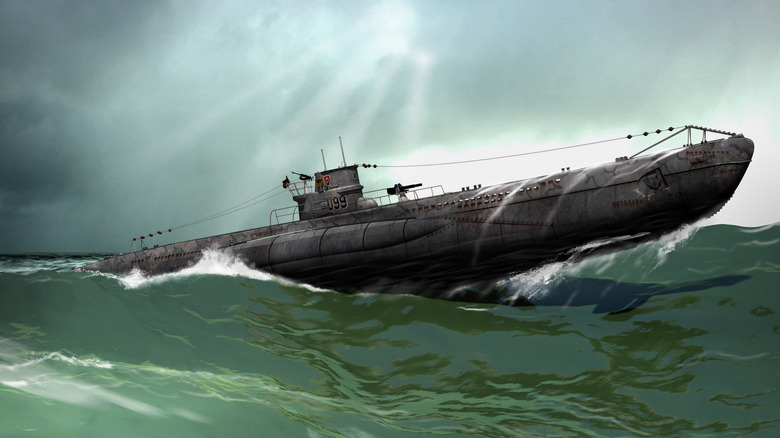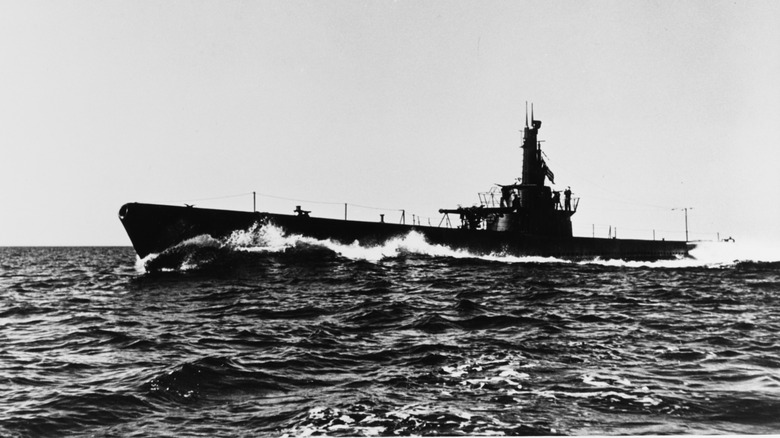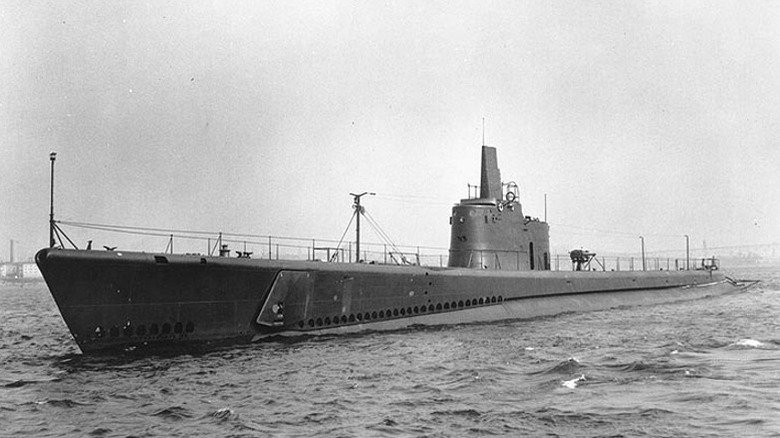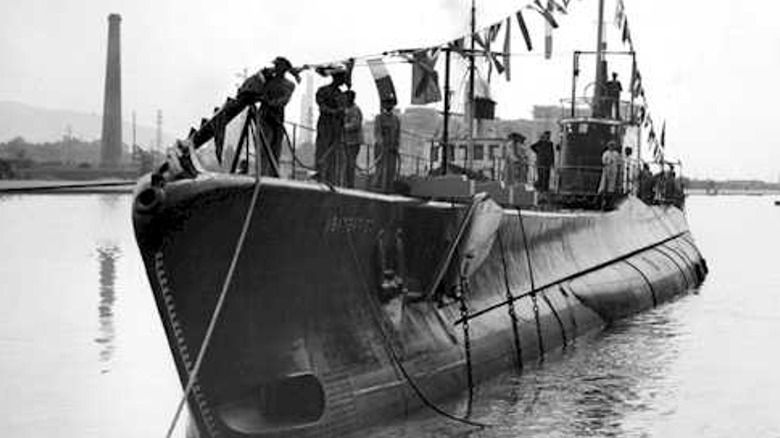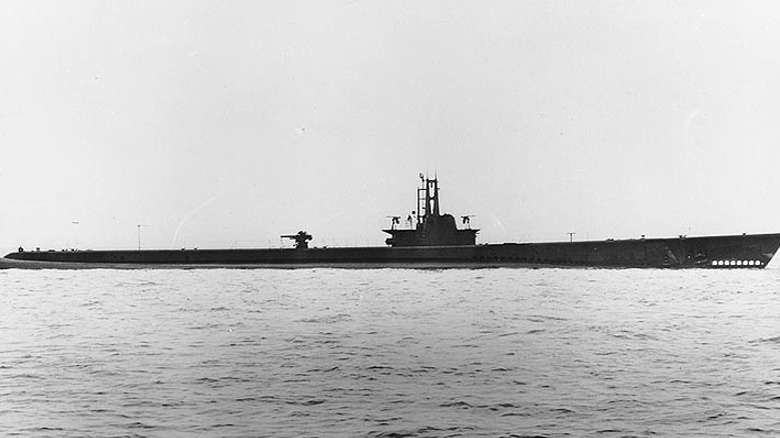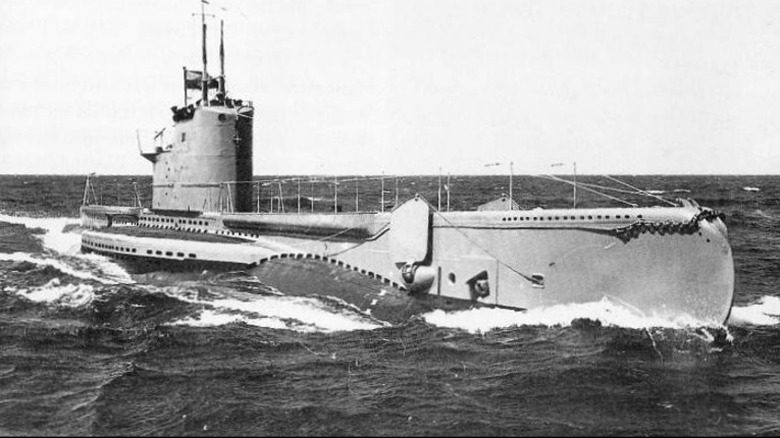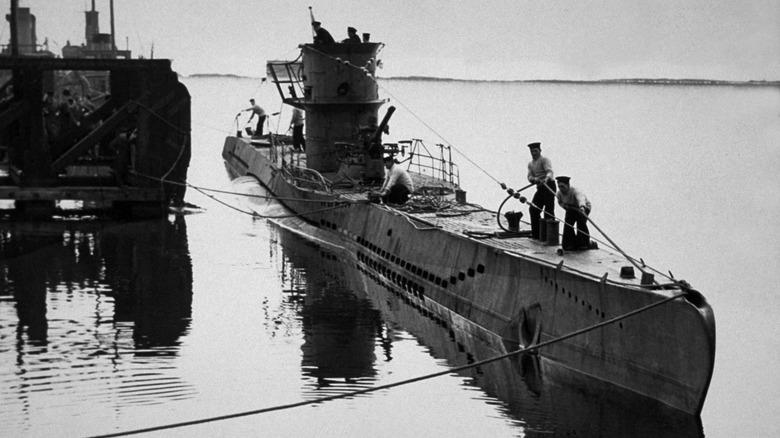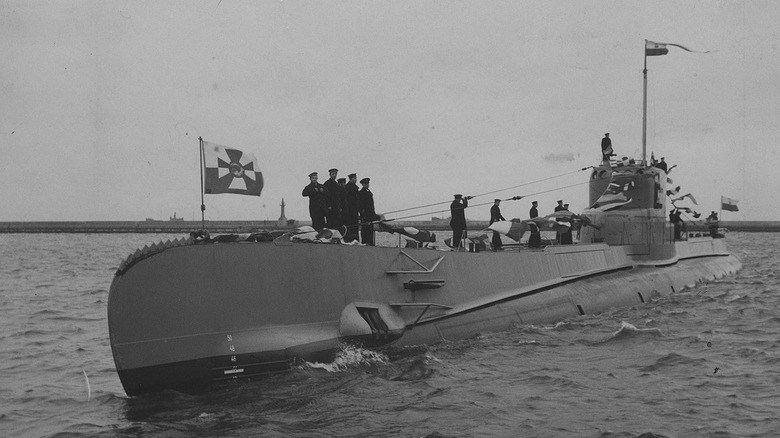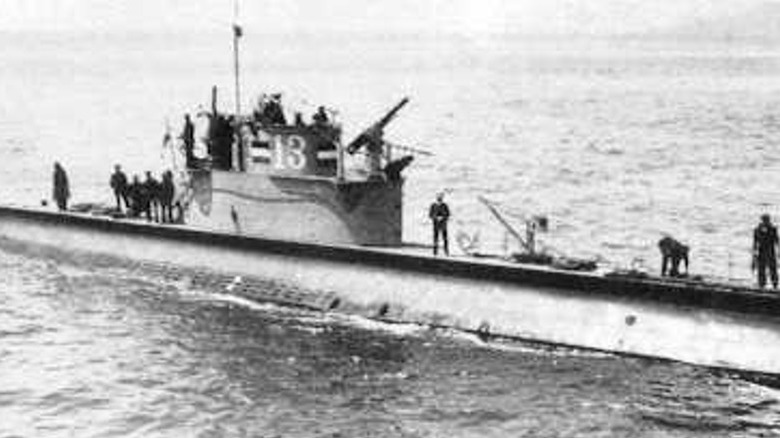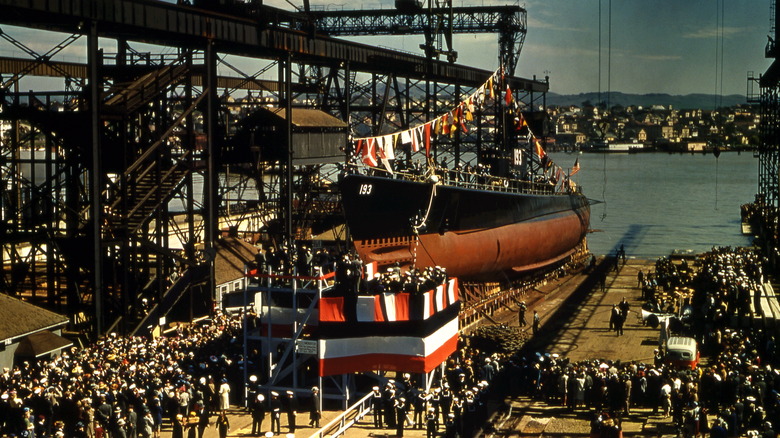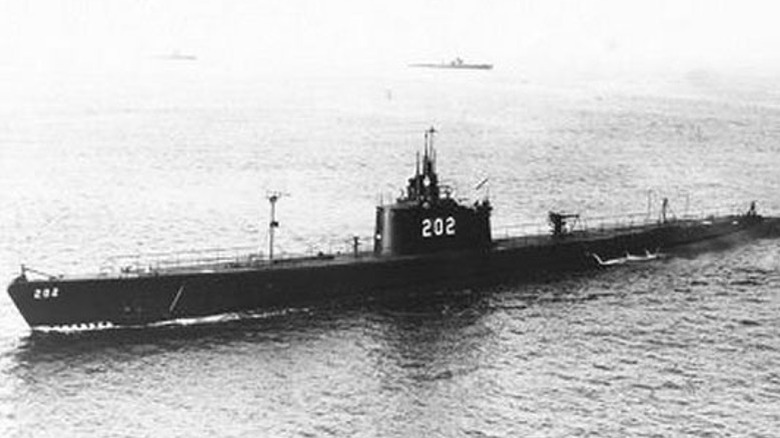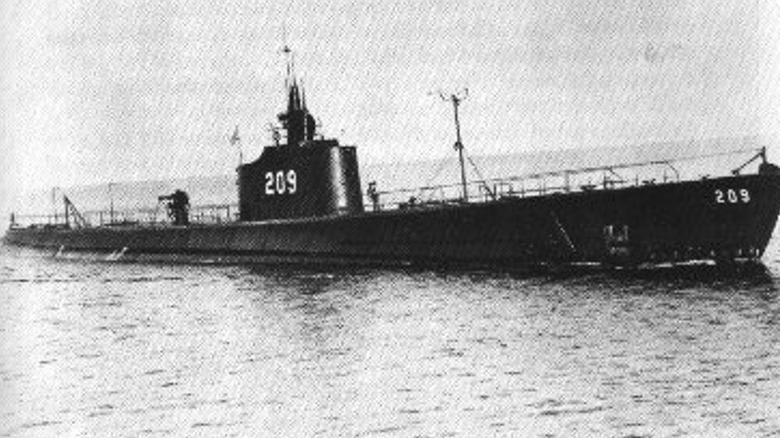World War II Subs That Went Missing And Were Never Found
Large bodies of water are notoriously unpredictable, and humanity's history with the sea is long and perilous. Still, there's one thing that's even more dangerous than sailing through the waves: traveling under them. Due to their very nature, submarines can be hazardous to your health even in peaceful times, and serving on one can be a very claustrophobic experience. Imagine, then, what it's like to be on one during wartime, when the cramped and creepy conditions are nothing compared to the fact that an enemy is actively looking to destroy your flimsy underwater vessel.
With enemies everywhere and a whole sea to disappear in, World War II was a particularly scary time to be stationed aboard a submarine. Indeed, many subs vanished without as much as a trace during these turbulent times ... and while some WWII-era sunken submarines have been discovered decades after they were lost, there are many that have gone missing and were never found. Here's a look at their strange, claustrophobic stories.
USS Capelin
The book "U.S. Submarines 1941-1945" by Jim Christley states that the USS Capelin and its crew of 78 men were lost at sea on December 1, 1943, but the truth is considerably more complicated. In fact, the story of this particular submarine shows just how mysterious the fates of these vessels could be during wartime, even when people were roughly aware of the area the sub was supposed to patrol.
The details of the Capelin's final days are murky, to say the least. Per the Navy Department Library, the submarine arrived in Darwin, Australia, on November 16 after its very first patrol mission, during which it sank two Japanese merchant freighters. It departed for its second patrol on November 17 after some repairs. This was the last conclusive sighting of the boat, and the only somewhat confirmed information of its disappearance is that it happened somewhere in the western Pacific Ocean, in the Celebes or Molucca Sea.
Around the time of the Capelin's disappearance, there were unverified and inconclusive reports of an unrecognized American submarine under attack by Japanese forces, and another submarine reported a potential sighting on December 2. Still, as Michael Sturma's book "The USS Flier: Death and Survival on a World War II Submarine" notes, the common belief appears to be that the sub succumbed to naval mines that were abundant in the area.
USS Amberjack
Some disappearances have little to no drama that can be perceived by an outside observer, but that doesn't mean they don't have mysteries to spare. Take the USS Amberjack, a U.S. Navy submarine that served on the Pacific front during World War II (via the Navy Department Library).
Using Brisbane, Australia as its port, the Amberjack achieved some notable victories during its third and final patrol, which started on January 26, 1943. It sank at least two ships, one of which was carrying explosives. It also reported an encounter with enemy ships and destroyers, and even managed to take a prisoner. However, that's all we know for sure. All the Navy can be certain about is that the Amberjack disappeared, taking all but one of its crew of over 70 men with it. Interestingly, the one man who we know didn't disappear lives on in Navy tradition. Before the submarine was lost, its Chief Pharmacist's Mate Arthur C. Beeman was confirmed to have died during a mission on February 4, and a recreation center at Pearl Harbor Submarine Base bears his name.
There is a possibility that the submarine was destroyed during a depth charge attack by enemy vessels on February 16, but there's little concrete evidence about this. The attack may also have been on another submarine called the Grampus, or both of them — or perhaps something completely different happened to the Amberjack.
Barbarigo
Of course, not every submarine that became lost during World War II was an American one. According to Cristiano D'Adamo of the Regia Marina Italiana website, one of the Royal Italian Navy's more infamous submarines was the Marcello class vessel called Barbarigo, both because of its numerous successful missions and some rather controversial "victories" it became associated with, thanks to one of its commanding officers, Enzo Grossi.
Grossi claimed in May 1942 that Barbarigo had managed to sink a massive 33,000-ton California or Maryland class battleship, and in October that year, he reported having done the same to a smaller but still impressive Mississippi-class one. (Per Paul Akermann's book, "Encyclopedia of British Submarines 1901-1955,"). The second sinking has later been confirmed as a massively embellished encounter with a much smaller British Flower-class corvette ship that Barbarigo didn't even manage to sink. As for the first one, the crew may have genuinely been under the impression that the attack was a success, but it later transpired that the American ship in question not only didn't sink ... but hadn't even noticed the Italian submarine trying to attack it.
Grossi's tenure notwithstanding, Barbarigo served well on numerous missions — but didn't survive the war. Converted into a trade submarine, it disappeared off the coast of Bordeaux, France, in June 1943. It is thought that the heavily-loaded vessel sank due to enemy activity, or simply broke down.
USS Kete
Three fallen enemies and a disappeared main character might sound like the end result of a spaghetti western, but according to the U.S. Navy book "United States Submarine Losses in World War II," this is also a pretty good description of the second and final patrol mission of the USS Kete.
The submarine left its base in the Western Pacific island of Guam on March 1, 1945 — and while its first mission had been entirely drama-free, this one featured plenty of action. Precisely what kind of action is another matter, though, because after sending in a weather report as part of its mission on March 20, the Kete and its crew of 87 men were never heard from again.
Here's what we know, though. The Kete sank no less than three freighters on the night of March 10. This, and an unsuccessful encounter with a fourth enemy ship, left the submarine with precious few torpedoes, and it was on its way to Pearl Harbor to deal with the situation. Obviously, it never arrived at its destination, but there's little indication of what actually happened to it. The Navy's best guess is that a Japanese submarine managed to sink it, but there are no records to support this theory. It's possible that the submarine that attacked the Kete was also destroyed before it could report this, which could have left the Kete's fate outside official record keeping.
Kalev
Estonia may not be known as a major player in World War II, but that doesn't mean the country didn't have submarines at play. According to the Estonian Maritime Museum, the country's two British-built Kalev-class submarines, Kalev and Lembit, were completed in 1936. Lembit is actually still around, leading a quiet existence in the aforementioned museum. Kalev, on the other hand, was not quite as lucky.
According to NATO's profile on Lembit, the building project of these subs was unconventional, as the people of Estonia effectively crowdfunded the project with scrap metal donations. However, Estonia didn't have a chance to enjoy its submarines for long. After the Soviet occupation of the Baltic States in 1940, the ships served as part of the Soviet Union's Navy presence in the area (per Uboat.net). Unfortunately, Kalev's service was short-lived, as it never returned from its second World War II mission. It's believed to have run into a mine on the Gulf of Finland in either October or November 1941. Details of the incident are somewhat scarce, but since Lembit had a crew of 32, it's probably safe to assume that Kalev's crew was the same size when it disappeared.
With Kalev gone, Lembit remains the world's last Kalev-class submarine.
U-972
Sometimes history can't quite decide whether the fate of a disappeared submarine is tragic or downright embarrassing. Such is the case with the German Type VIIC submarine U-972 (via Uboat.net), which the Navy Department Library lists as lost to unknown causes, somewhere in the North Atlantic area, in January 1944, presumably based on the fact that it was noticed to be missing on February 1, 1944. However, the true story behind the ship's sinking might be even stranger. Jak Mallmann Showell's "Hitler's Navy: A Reference Guide to the Kriegsmarine 1935-1945" and Douglas E. Campbell and Charles R. Hinman's "The Submarine Has No Friends: Friendly Fire Incidents Involving U.S. Submarines During World War II" both state that the U-boat was sunk by its own torpedo.
Such an incident could have been possible with German T5 acoustic torpedoes, which homed in at sound sources, but took a circular route when they detected the first sound. This was an effort to circumvent the fake sound sources known as "foxers" that British ships often towed behind them, but because of it, the torpedo could potentially have picked up the sound of U-972 and targeted the U-boat itself, instead of the intended target. Per Showell, another U-boat known as U-377 also succumbed to a similar fate.
Regardless, U-972's fate remains officially unknown ... and while "lost for unknown reasons" might seem less unfortunate than "sunk by its own torpedo" on the page, it's of little significance to the 49 people who disappeared with the submarine.
Orzel
Don't let the fact that the Polish submarine Orzel is on this list fool you. Though it eventually did disappear, the events that led to its ultimate fate were straight out of a particularly impressive wartime thriller. The Orzel's crew and its captain, Jan Grudzinski, didn't particularly care for Nazis, and when Germany invaded Poland in September 1939, they promptly relocated the Orzel to Estonia. Unfortunately, it wasn't any safer there, as the local authorities were too concerned by the Nazis to let the Orzel do its thing. Instead, they captured Grudzinski's crew and started removing the sub's weapons and operational equipment.
The Estonians thought Grudzinski was fine with this ... which is exactly what he wanted them to think. In reality, he and the crew were busy staging a daring escape plan that involved hostages, a harbor-wide blackout, and a desperate reverse-gear escape under artillery fire after the submarine got stuck. This, however, was just the beginning. They now had to make it to the U.K. with no navigation equipment, in waters that were full of German ships that wanted a word. It took 44 days of movie-worthy close calls and desperation maneuvers, but they ultimately managed to get there.
The Orzel's heroic escape became an international news story, but unfortunately, the good times didn't last long (via The New York Times). In June 1940, the Orzel and its crew of 54 were reported to have disappeared during a patrol mission in the North Sea.
O-13
The number 13 isn't exactly known as a lucky one in most walks of life, and in 1940, the Dutch submarine O-13 tragically demonstrated that naval warfare may not be exempt from this particular superstition (via the BBC). O-13 disappeared without trace during a patrol mission, having left its base in Dundee, Scotland, on June 12, after reports of increased German activity in the area between Norway and Denmark surfaced. The submarine and its crew of 34 men never returned, and it remains the sole missing WWII-era Dutch submarine despite attempts to locate its wreck. There are many theories as to what happened to the vessel. The most prevalent one is that it had a fatal encounter with a sea mine, while others indicate that O-13 may have encountered the enemy it was patrolling for, or even accidentally collided with a friendly submarine.
Regardless of the reason behind O-13's disappearance, it happened mere months after escaping Germany's invasion of the Netherlands in May 1940. Though the submarine's time with the Royal Navy was cut extremely short, it played a supporting role in one of the biggest moments of the war, protecting the ships that carried out the Dunkirk evacuation.
USS Swordfish
When a submarine disappears, it doesn't mess around. On one day, everything could be right as the proverbial rain, and the next thing you know, the vessel is gone like the sea just swallowed it ... which, of course, is very much a risk that submarines face.
This is all the more noticeable when the submarine that disappears like this is one like the USS Swordfish. According to the Naval History and Heritage Command, this first submarine bearing the "Swordfish" title started its active war patrols immediately after the December 7, 1941 attack on Pearl Harbor. Incidentally, the Swordfish itself had been stationed in the ill-fated naval base, but was in another location during the attack itself. For the following four years, it went on to do its level best to settle the score. The Swordfish ran a total of 13 missions, performing important operations like high-profile evacuations, and damaging and sinking a great many Japanese ships with gusto.
That 13th mission, however, is where the Swordfish ran out of luck. On December 22, 1944, the submarine left Pearl Harbor to patrol the Nansei-Shoto island chain, but radio contact was lost after January 2, 1945. Its fate remains unknown.
USS Trout
Per the Naval History and Heritage Command, the USS Trout was a highly decorated submarine that performed several massively successful and destructive patrols of the Pacific, after the attack on Pearl Harbor. The submarine took on numerous ships, and sank many of them. However, the enemy vessels weren't taking it sitting down, and the Trout had several close calls, where it had to dodge torpedoes and withstand horrifying depth charge bombings that sometimes shook the vessel so violently that the crew members were thrown around the interior. The 84-strong crew of the Trout also found firsthand that torpedoes aren't always the most reliable weapon out there. Many of its torpedoes missed, and on more than one occasion, even direct hits were ineffective because the torpedo warheads were duds.
The Trout's 11th mission started on February 8, 1944, and proved to be its final one. The submarine was last seen refueling on February 16, and is thought to have disappeared somewhere in the vicinity of the East China Sea. The Navy suspects that the Trout went down fighting, since it was in an area where a submarine attacked a Japanese ship convoy on February 29, but exactly what happened to the submarine in question — and whether it was the Trout in the first place — remains a matter of speculation.
USS Grayling
On the surface, the story of USS Grayling isn't too different from many other tales of disappeared submarines. However, while the submarine's loss remains a mystery, the Navy Department Library refers to Japanese reports that surfaced after World War II was over, suggesting that the Grayling might have suffered a truly peculiar fate.
One of the subs actively operating in the Pacific after the attack on Pearl Harbor, the Grayling started its patrols on January 1942, sinking 16 ships over the course of eight missions, before its disappearance sometime in late August or September 1943. Said disappearance has been attributed to potential malfunctions or enemy attacks, but the aforementioned Japanese files have suggested something very different: that the Grayling was run over by a ship.
Though the Navy's last communication with the Grayling happened on August 19, the Japanese reports describe submarine activity in the Tablas Strait area, where it could well have operated at the time. These sightings range from August 29 to September 9, which is when a ship called Hokuan Maru came in (per The United States Navy Memorial). The Japanese ship spotted a barely submerged vessel in shallow waters and promptly ran over it, reporting a clear impact. It's entirely possible that this marked the end of the Grayling and its crew of 53 men.
